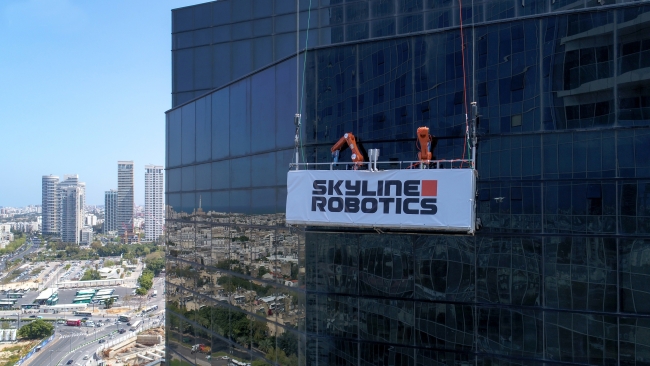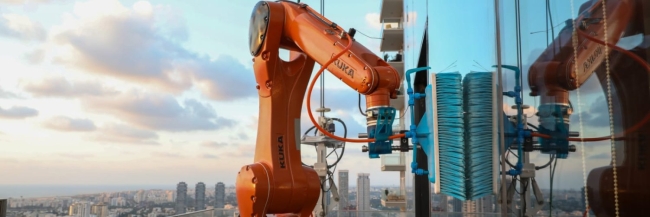5 minute read • published in partnership with KUKA
Case Study: KUKA and Skyline Robotics climbing to new heights
Skyline Robotics has achieved beyond what many other companies have attempted but failed to perfect. The Tel Aviv-based company has succeeded in automating window washing for the world’s skyscrapers – a task that has been done manually for over 100 years.
Ozmo: KR AGILUS, computerized vision system and AI at their best
To automate the window-cleaning task, Skyline developed Ozmo, a system that combines KUKA’s KR AGILUS with a computerized vision system, artificial intelligence (AI) and machine learning technologies. What formerly required three to four months of manual labour, Ozmo does automatically in about half the time. But most importantly, the system ensures safety by removing human workers from the window washing platform or “basket.”
Manual window cleaning may take three or four people – two in the basket, one on the roof and, in some cases, another person on the ground. Ozmo requires only one person on the roof to control the basket, power and water sources, and crane, while the robot does the cleaning.

Skyline Robotics has succeeded in automating window washing for the world’s skyscrapers – a task that has been done manually for over 100 years / Picture: KUKA
Five years of preparation for perfect cleaning results
For its power and water supply, Ozmo is designed to fit into a building’s existing building maintenance unit (BMU) infrastructure, gathering the power and water supply from the building itself. Within the basket, a table houses several types of sensors and computers. The robotic arm and its Lidar (light detection and ranging) camera, which uses lasers for imaging, sit on top of the table. The Lidar camera uses class 1 lasers which are safe for humans. Once the table is clamped into a building’s preexisting window-washing basket, the system is ready to work.
According to Ross Blum, President and COO of Skyline Robotics, the Skyline team has been working on the Ozmo project for the past five years, conquering many technological hurdles along the way and taking iterative steps to integrate all the necessary components and features. These include the KR AGILUS itself and the programming that enables its arm to mimic human movements for cleaning windows.
How Ozmo gets to see, feel and think
Ross Blum uses analogies to the human senses when he explains how Ozmo is working: “The robot arm communicates to the Lidar camera that provides ‘sight’ for the robot and to a force torque sensor at the end of the cleaning brush that gives Ozmo the sense of ‘touch’,” explained Blum. “The system software acts as the brain and collects data from several different cameras and sensors to continually optimize the path planning at a rate of about 200 times/second, while automating Ozmo’s descent down the side of a skyscraper.”
From weatherproof to world-class
For the Ozmo system, Skyline employs a KUKA KR AGILUS Waterproof in tandem with a software-based AI that makes the window washing application possible. Skyline developed an algorithm that allows for feedback for force control and other variables that then control how much pressure the robot applies to the glass.
The robot’s reach extends 1.1 meters. According to Blum, “one of the biggest factors in Skyline choosing KUKA was not only the credibility of the brand and the world-class team that stands behind it, but also because KUKA’s robot arm can handle the rigors of an outdoor environment, while the majority of other brands fail to do so.” He went on to say that the robots are IP67-rated and very reliable, and that their six-axis motion was also important to Skyline, especially approaching complex façade geometries they encounter on a building.
More flexibility due to KUKA KR C5 micro
The KR C5 micro controller also played a big role in meeting platform weight limitations, which vary on a global basis. The controller weighs 9.8 kilograms which is as much as 16 kilograms less than other options, and takes up considerably less room. In some instances, this will allow Skyline to place multiple arms in one basket, even with lower weight limits.
“We want to dominate the frontier when it comes to bringing robots outside of controlled environments,” said Blum. “And to accomplish that, we believe KUKA is the right automation supplier with which to partner. They are willing to take robotics beyond the typical applications, and we look forward to working more closely with their engineers to develop products specifically designed for the outdoor environment.”

‘Ozmo’ combines KUKA’s KR AGILUS with a computerized vision system, artificial intelligence (AI) and machine learning technologies / Picture: KUKA
Even gusts won’t stop Ozmo
All the technology incorporated into Ozmo is extremely advanced, especially its software and world class hardware components. They allow Skyline to not only control and adjust the robot’s movements on the fly but also to stabilize – in real time – the system basket/platform in which the robot rides. What makes this so challenging is having to adjust for unexpected variables such as wind gusts or peculiarities of crane kinematics, which could cause one side of the basket to descend further than the opposite end. Ozmo can process all these variables and compensate instantaneously to ensure quality cleaning and the most efficient descent path to do so.
For stabilization, Ozmo uses its KR AGILUS to apply a counterforce to an unstabilized basket. The robot’s arm stays against the building window for an additional half second to keep the basket from rocking. According to Blum, Skyline is the first and only robotics company to successfully use the robot’s arm in this fashion.
It takes experience and strong partners to succeed
“A lot of robotics companies want to get into the automated window cleaning business,” said Skyline Robotics Chairman and CEO Michael Brown. “The truth of the matter, however, is that doing so is very complex and mathematical, especially in terms of AI and machine learning. You can’t just slap a robot in a basket and think that’s all there is to it. We’ve been working with window washers for years to perfect our system and ensure that it has the necessary algorithms to account for variable environments.”
He also noted that partnerships have been key to the development of Ozmo. “KUKA has been advising us every step of the way, and we really couldn’t ask for a better partner,” he said. “Once we’ve completed what I call the proof-of-concept stage in New York City, we plan to reconvene with KUKA to discuss and gain insight as to how we might tweak or further improve our product with their technology. For us, collaboration with KUKA is critical to the success of our business.”
Support for Ozmo in New York City
For the aforementioned proof of concept stage, Skyline Robotics has now been granted extensive support. The company announced the successful completion of a $6.5M funding round. Skyline Standard Holdings led the round with contributions from Kärcher New Venture GmbH, Gefen Capital and others. “Kärcher is pleased to continue to support Skyline Robotics on its mission to create a more efficient and safer work environment for window cleaning on a global scale,” said Patrick Nennewitz, Head of Corporate Venturing at Kärcher New Venture GmbH. Nennewitz added: “Skyline’s ability to transform an industry with robots while still creating jobs is a model that other robotics companies should replicate. With buildings getting taller and the workforce shrinking, Skyline’s arrival is as timely as it is necessary.”
